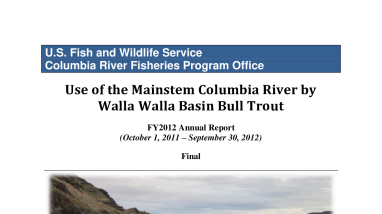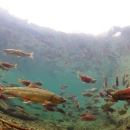A significant gap in our knowledge of migratory bull trout Salvelinus confluentus life history is associated with their use of the mainstem Columbia and Snake rivers. Few data are available regarding movements within the mainstem, the use of various mainstem habitats, or bull trout presence and passage at mainstem dams. We conducted our sampling effort for bull trout from October 2011 through February 2012 during the time period when most of the emigration from the Walla Walla Basin occurs. Twenty bull trout were captured in the lower Walla Walla River between 16 November 2011 and 9 February 2012, fifteen of which were subsequently tagged with acoustic transmitters and full duplex ISO 134 kHz passive integrated transponder (PIT) tags. Tagged bull trout ranged in fork length from 215 to 438 mm and their weight varied from 102.0 to 797.5 g. Six of those fish moved into the Columbia River and we were able to obtain locations on two during mobile tracking surveys. Emigration of acoustic tagged bull trout from the Walla Walla River occurred between 19 December 2011 and 31 January 2012. The two bull trout we located moved upstream toward the confluence of the Snake River, but were not relocated further than 13 river kilometers (rkm) upstream from the mouth of the Walla Walla River. One additional bull trout was detected on the Wallula Gap fixed hydrophone array approximately four rkm downstream of the mouth of the Walla Walla River heading toward McNary Dam. Only one acoustic-tagged bull trout was detected while returning to the Walla Walla River from the mainstem on 18 February 2012. In addition, 96 migratory bull trout were PIT-tagged in middle Basin areas. Emigration of PIT-tagged bull trout occurred between 31 October 2011 and 30 January 2012. Our quantitative estimate of the number of Walla Walla Basin bull trout that may have used the Columbia River during the 2011/12 migration season was 41 (95% CI 21-87). Immigration of PIT-tagged bull trout occurred between 10 April 2012 and 29 May 2012. One PIT-tagged bull trout from the Walla Walla River was detected while ascending the adult ladder at McNary Dam from 26 June through 29 June 2012. Another bull trout PIT-tagged in the Walla Walla River as part of this project, was recaptured while ascending the adult fish ladder at Three Mile Falls Dam in the Umatilla River. Subsequent genetic assignment of this fish and seven other bull trout captured at this location since 2007 indicated that all eight of the bull trout captured originated from outside the Umatilla Basin. Most (N = 7) originated in the South Fork Walla Walla River, and one was from the Tucannon River. It is unknown if this connectivity with the Umatilla River was intrinsic, or induced by the presence of McNary Dam. Weather and river conditions in addition to the large size of the study area limited our ability to determine the extent of movements and distribution, and to collect detailed habitat use data.
Publication date
Type of document
Report
Facility
Program
Species
FWS Focus
Ecosystem
FWS and DOI Region(s)





